by Trish Adams | May 15, 2014 | Nutrition, Stress
Just recently I happily said good bye to a year of chronic work-related stress. It was likely the longest period of stress that I’d ever experienced, and it showed in how I ate, how I slept, how I looked and I’m sure my family would say my mood. During times of chronic stress (whether real or perceived), stress hormones like cortisol stay elevated. This can lead to a decreased metabolic rate, sleep disruption, a drop in serotonin (aka happy hormone), and turn our appetite toward fat, sugary foods and other carbs. Eating is a part of life, but when our hormones are out of whack sometimes we can go overboard and emotional eating comes in to play.
Emotional eating may reflect on the scale but it begins in the mind. Stress wreaks havoc in many areas of our lives and our nutrition is just one. When your defenses are compromised your health takes a hit and so do your emotions.
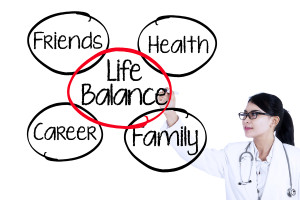 Everyone has days that seem like they couldn’t get any better and days that we wish never were. How we deal with the challenging ones has a direct impact on our ability to combat emotional eating. We seek comfort when we are hurt and turn to food as a coping mechanism. Foods don’t judge us, hurt us or tell us “no.” Additionally, eating foods that bring us pleasure can stimulate the release of endorphins similar to exercise. So, after you eat, you feel better although it may be short-lived.
Everyone has days that seem like they couldn’t get any better and days that we wish never were. How we deal with the challenging ones has a direct impact on our ability to combat emotional eating. We seek comfort when we are hurt and turn to food as a coping mechanism. Foods don’t judge us, hurt us or tell us “no.” Additionally, eating foods that bring us pleasure can stimulate the release of endorphins similar to exercise. So, after you eat, you feel better although it may be short-lived.
Emotional eaters use food as a stress relief mechanism. When we are unable to find a solution to our problems or somehow alleviate our stress, we turn to food. This is especially common when the stressor is something horrible such as physical abuse or a death.
Are you an emotional eater?
Determining whether you might be using food as a crutch requires a closer examination of what’s going on in your life. A key indicator would be unexpected weight gain. Obviously if you are following a reset or bulking program this might not be a sign you can rely on. However, if you are experiencing weight gain, take a closer look at these areas which are common sources of stress:
- Has your work or home life been more stressful than normal?
- Have you, a family member or friend experienced any recent trauma?
- Is there a problem that you have been wrestling with but haven’t found a solution for?
If you responded “yes” to any of these questions and are experiencing unexpected weight gain, emotional eating might be the culprit. Not only might you be eating when you are not necessarily hungry, but the foods you are eating might be “comfort foods”. Characteristics of comfort foods include:
- High fat foods like fried foods such as French fries
- High carb foods like macaroni and cheese or mashed potatoes
- Sugary foods like ice cream, donuts, cookies, cake
 Coping with day-to-day stress
Coping with day-to-day stress
So, you might be wondering what you can do about emotional eating once you have determined that you have a problem. Emotional eaters often experience feelings of helplessness followed by guilt. The guilt is triggered by the indulgence and its potential effect on your health while the helplessness lies in not seeing a way out of the situation.
In this scenario a nutrition coach or nutritionist might not be what you need as emotional eating has nothing to do with dieting or changing your eating habits. Rather seek a counselor that will help you deal with the emotions you are experiencing and gain control over them. Some activities a counselor might suggest include
- visualization, helping you to reframe your problems and see them in a realistic way rather than blowing them out of proportion.
- learning new problem solving skills
- mind-body programs such as meditation or deep breathing
- exercise can serve as a distraction from the stressor as well as alleviate frustration
Also consider setting up a support system of friends and family who can help you be aware of the foods you are eating, assist you in making healthy food choices and exercise along with you. Taking control of emotional eating starts first with dealing with the stress. Finding new ways to solve our problems will push emotional eating out of the equation.
Photo credit: creativa/bigstock.com

by Trish Adams | May 13, 2014 | Building Muscle, Fat Loss / Cutting, Increasing calories, Interviews/Guest Posts
Team EM2WL would like to extend a warm welcome to our newest guest blogger, Jared Harris, a recent college graduate with a passion for writing and fitness! Today, Jared shares a series of tips on how to get motivated when winter is over!
We all know how important it is to exercise and eat right. We also all know how easy it is to slip into a winter season of laziness and comfort food-holiday weight gain and the convenience of a big black pea coat. But as summer makes its way ever so slowly to our hemisphere, we have to start facing the music. And it’s not easy. I know I am far more hesitant about throwing on a pair of running shorts and hitting the gym when I’m feeling those extra few pounds. I know after a long day at work, sometimes all I want to do is grab a bag of popcorn and sit in front of the television.
So, we additionally know what we’re up against and what we should do about it. Exercising and eating right are great, but it’s really in how we do those things  that counts. Eating right does not by any means translate to skipping meals, starving yourself, or only eating foods that you don’t like. And exercising does not necessarily translate to running miles upon dull miles on the treadmill. It’s all about balance and achieving the right body composition for you. According to a study done by IDEA Health & Fitness Association, as reported by Examiner, “weight training is indeed fat burning exercise.”
that counts. Eating right does not by any means translate to skipping meals, starving yourself, or only eating foods that you don’t like. And exercising does not necessarily translate to running miles upon dull miles on the treadmill. It’s all about balance and achieving the right body composition for you. According to a study done by IDEA Health & Fitness Association, as reported by Examiner, “weight training is indeed fat burning exercise.”
Finding the time to exercise, as well as keeping up with nutrition is a lot. But for many people, negative body image and failure to accept themselves are really what’s keeping them from the healthy lifestyle they want and know they need. As one physician wrote on Sharecare, “The key to having a healthy lifestyle and sticking with it is you. If you are down on yourself, the less likely you are to succeed and the more likely you are to give up… Staying positive and focusing on all that you have accomplished will help you win the weight loss, exercise for life change game with joy.”
So here are some ways to integrate your workouts; to make sure you are taking care of your BMI, your heart, your muscles and joints, your mind, your moods, and your self-esteem.
Consider Weight Lifting
It’s not just for men who want to bulk up. In fact, muscle strengthening workouts are crucial for healthy body composition and weight loss, which many people don’t realize. Experience Life featured an article about one woman’s quest to lose weight after having children; the key to her success turned out to be “shorter, more intense workouts with weights that were never the same from one day to the next,” rather than what she’d been trying before, which was essentially just running off the extra weight. Often, we can get bogged down in hours of aerobic exercise when really, the combination of strength training and aerobic exercise together is the key. Health magazine recommends doing “all-over strength workouts 2-3 times per week leaving at least a day’s rest in between.” If that is not working out your whole self, I don’t know what is.
Take Control of Your Health
With ever-improving technologies to help track health and fitness, it’s becoming easier to have one go-to gadget to consult with about what’s next on your exercise or diet plan. For example, Verizon Wireless writes that an upcoming phone, the Samsung Galaxy S5, will arrive with the S Health program to “track your steps, challenge friends, earn badges and get on–demand healthy eating advice.” Interesting, though even more so is the built–in heart monitor that’s apparently a first in the mobile phone world. In other words, it looks like an all-in-one way to keep track of your plan—and stick with it.
Feed Yourself
Many people think staying healthy is all about painful, joyless exercise and restriction in food intake. That’s all wrong. We stick with exercise plans when we enjoy them and we are our healthiest when we’re eating a variety of lots of different foods. Not getting enough calories limits nutrition and makes the body slow its metabolism. Instead, as Cameron Diaz points out in her new book, reviewed by the New York Daily News, there is a rationale behind embracing the “the instinct of hunger” by satisfying it “with whole, nutrient-dense foods.”
No matter what your goals are, health is always about a balance of mind and body. Be sure you keep your goals in mind (or in hand), take in enough nutritional foods to keep your immune system healthy and your metabolism going strong, and always accept and love yourself wherever you are each day.
Photo credits: Gualberto107, stockimages

by Trish Adams | May 7, 2014 | Former Fitness Competitors, Interviews/Guest Posts, Intuitive Eating, Nutrition, Self Acceptance

Dani Shugart
After following Dani for some time, I was so excited to finally have an opportunity to get into her head a bit deeper. This figure competitor knows firsthand the dangers of disordered eating and helps her clients break the cycle and rebuild their relationship with food.
EM2WL: Thanks again, Dani, for agreeing to be interviewed. Just to give everyone a brief background, you started lifting in high school which led to competing and winning several competitions, most recently taking first place in novice and third place in open at this year’s Axis Labs Northern Colorado’s figure competition. You’ve also authored several articles and recently published The Sound of Secrets: End Disordered Eating, recounting your sister’s battle with the disease. Why did you feel the need to write this book?
Dani: I wrote this book after losing my big sister. She struggled with anorexia for nearly two decades, and a few months after her death it occurred to me that my sister’s struggle, though extreme, started somewhere fairly benign, at a place where a lot of women find themselves now.
I wrote the book to stop women (and men) from going down that same route, and to help them break out of the eating habits that make them feel and look miserable.
 E: In your book you labeled disordered eating as the new normal. How do you think society has come to this state?
E: In your book you labeled disordered eating as the new normal. How do you think society has come to this state?
D: I don’t know if we can blame any one thing. It would be easy to point the finger at Photoshop, the media, and the underrepresentation of strong, healthy bodies. But I think it’s more complicated than that.
I have to wonder if the rise in disordered eating is just a backlash (a strong and adverse reaction) to the rise in obesity. Maybe people are just trying to avoid becoming the norm but going about it in counterproductive ways. There’s a general misunderstanding about how to be lean and healthy for the long haul.
Another thing that might have something to do with it is the increasing availability and consumption of hyperpalatable, processed foods. The salt/sugar/fat trifecta makes a lot of people compulsive overeaters. (It had that effect on me.) And when people want to be thin, yet become addicted to foods that do the opposite, they resort to compensatory actions instead of building a healthier relationship with foods that nourish.
Any level of disordered eating is a thief of our happiness, sanity, health, time, self respect, and potential.
E: Do you feel that many of today’s popular diets like paleo or IF contribute to the problem? What are your thoughts on IIFYM?
D: I think modern diets are just a symptom of a problem that’s already there. Sure, they can contribute to it and overcomplicate it, but diets are not where the problem begins. The problem begins in the mind, and it begins with our perception of what will make us healthy, fit, lean, and happy long term. Those who are obsessed with weighing less at the expense of their health are at risk for disordered eating, no matter what diet they subscribe to.
IIFYM (like many dieting strategies) can be beneficial or harmful depending on what your mindset is when using it. If you’re really focused on nourishing yourself then it can be used for good. It has its place, but it’s not a way of life. Counting and measuring everything you eat for your lifetime is insanity. Are you going to take scales and measuring cups with you everywhere you go? At some point you have to trust your ability to eye-ball an appropriate amount of food, and then eat according to your hunger. At some point you have to trust that your metabolism will work in your favor and use everything you consume.
Another thing — avoiding hyper-palatable food, the stuff that’s engineered to make you eat more, is a good idea. But I don’t see that as dieting, just self-defense. And filling your body up with what you know will nourish and satiate, is the best way to take care of yourself and become leaner in the process. No diet necessary.

E: When most people think of disordered eating, images of purging or extreme restrictive dieting come to mind. Would you consider behavior where someone regularly over indulges on the weekend and then tries to ‘burn it off’ or restrict calories afterward to be disordered eating?
D: Yes, this is definitely disordered. Anytime you overindulge and then try to compensate for it, you’re engaging in what I described in the book as the “binge-punish” cycle.
When working with clients, I also refer to it as the Good Girl/ Bad Girl cycle or Good Boy/Bad Boy cycle. People perceive their behavior as “bad” when they lose control, and then they perceive their behavior as “good” the next day when they try to undo the damage. A lot of folks go through this cycle every single day and don’t realize it’s disordered… all they see is the weight gain that happens as a result. So when I work with clients who are want to lose weight we have to address this cycle first.
E: In your book you describe the 5 phases of the binge-punish cycle which start with highly addictive engineered foods and ends with bingeing. What are some ways people can break this cycle?
D: There are so many ways to break the cycle and they all depend on the person. But here are three that I often use with clients:
Breaking the cycle begins when you have the most control. If you end the day famished and tired, you’ll be more likely to default to whatever behavior is easiest or most habitual. This often means choosing the most convenient food – whatever it may be. So if you’re used to eating food that makes you crave more, you’re going to grab that in a moment of weakness. To break the cycle, nourish yourself early and often, and you’ll prevent the need to reach for things that don’t serve you.
 Another way to break the cycle is just to make sure that your (home and work) environment accommodates it. Make sure you have healthy go-to foods available everywhere you are so that even if you are tempted to seek foods that trigger more eating, you have another easily available option.
Another way to break the cycle is just to make sure that your (home and work) environment accommodates it. Make sure you have healthy go-to foods available everywhere you are so that even if you are tempted to seek foods that trigger more eating, you have another easily available option.
Another way to break the cycle is to find out why you’re eating. Is your reason for eating physical or psychological? Check in with yourself and ask, “Am I eating this because I’m really hungry, or am I looking for a distraction and mental relief?” Strong emotions can start the cycle, and if you can get down to the bottom of WHY you’re reaching for food in the first place, then you can begin to establish strategies to deal with these emotions aside from food.
E: How important is it to have self compassion when trying to break free from disordered eating?
D: Self compassion doesn’t come naturally for most of us because we operate under the assumption that if you’re hard on yourself you’ll be more successful. This is a giant misconception and I think it’s what keeps people locked in their disordered eating.
Fighting against yourself instead of fighting on the same team makes it much harder to reach your goals. Once people really grasp this, they’re able to help themselves and break free. Self compassion is getting on your own team, and I think it’s essential for success.
For those that are suffering from disordered eating what are some steps they can take toward rebuilding their mindset about food?
Seek understanding. Find resources (books, coaches, articles, other people) that can help you change your mindset. Focus on changing your thinking and behavior instead of your macros and calories.
Women tend to get excited by weight loss no matter how it’s accomplished.
E: Fitness and strength training have obviously been a big part of your life. At EM2WL we encourage women to lift heavy weights and often run into the ‘fear of getting bulky’ objection. What do you say to women when faced with a similar concern?
 D: This is one of my favorite things to address. If you’re trying to change your disordered eating you have to change your disordered thinking. See if you can let go of the smallness goal because ironically, the strategies that make you weigh less initially are the same exact ones that either backfire and make you gain weight in the long run, or enslave you in a life of wasting away.
D: This is one of my favorite things to address. If you’re trying to change your disordered eating you have to change your disordered thinking. See if you can let go of the smallness goal because ironically, the strategies that make you weigh less initially are the same exact ones that either backfire and make you gain weight in the long run, or enslave you in a life of wasting away.
When you lose weight without building muscle you become a “smaller” person. And as such, you have to eat fewer and fewer calories (otherwise you’ll go right back to the same weight you were). But muscle changes that. It makes you expend more energy, and it requires you to consume more energy to grow.
Muscle not only ups your metabolism it also makes you look leaner. No matter how much weight you’re carrying, muscle will change the shape of your body like nothing else. And in order to have muscle definition, you have to have muscle. There’s no way around it.
E: Thanks again Dani! How can our readers hear more from/follow you?
D: Thanks for letting me share! Get in touch! Here’s where you can find me:
Website: http://www.goodgirlfitness.net
Facebook: https://www.facebook.com/GoodGirlFitness?ref=hl
Twitter: https://twitter.com/DaniShugart
Instagram: http://instagram.com/danishugart
Photos credit: www.bigstock.com
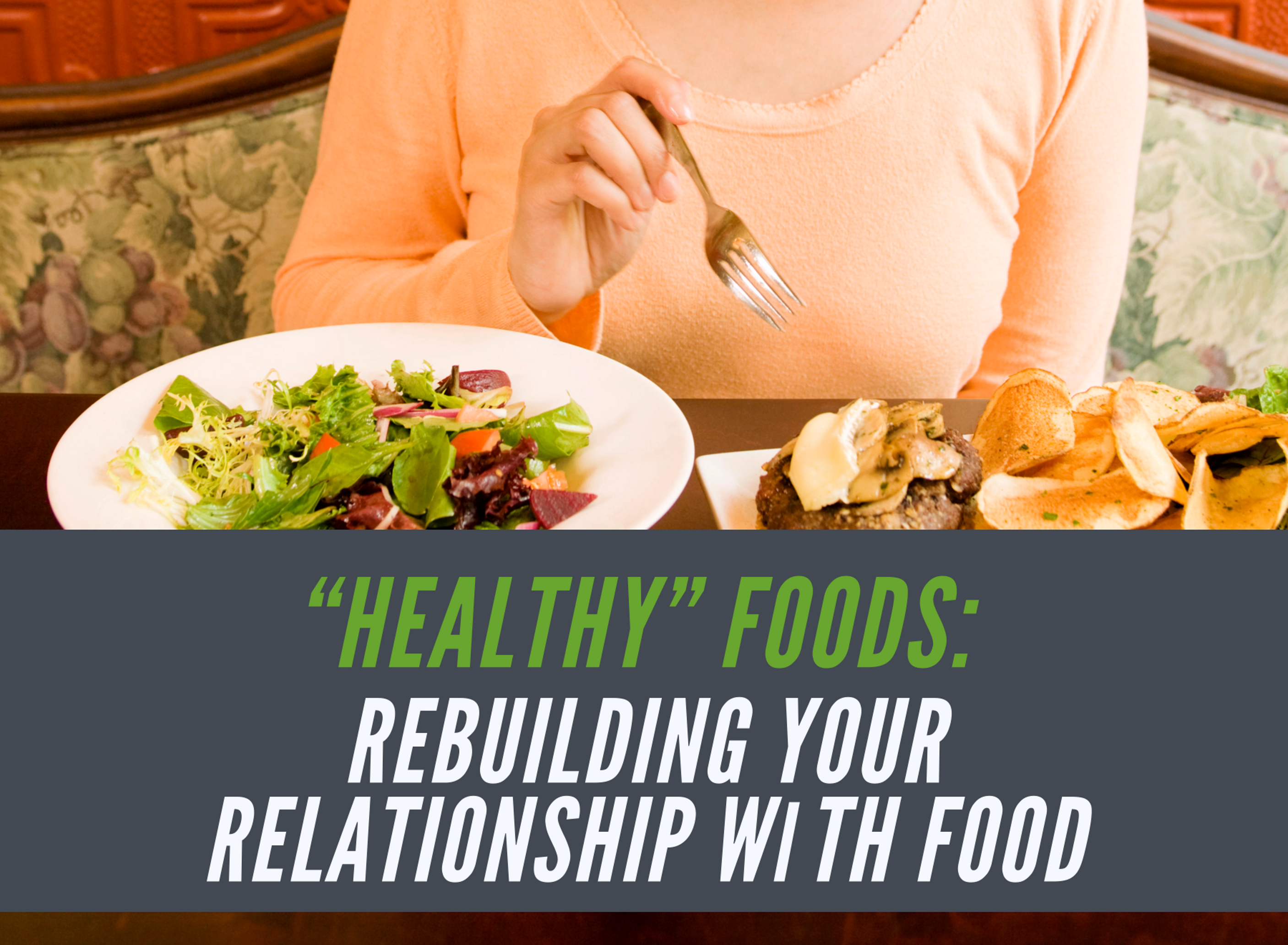
by Trish Adams | Apr 17, 2014 | Consistency, Nutrition
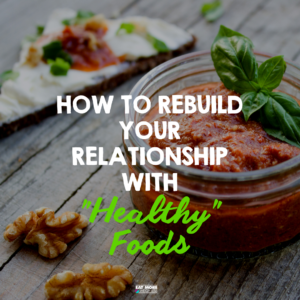 It’s no surprise that most folks go оn а diet tо lose weight. We watch what we eat, how much we eat and even throw in some exercise for good measure. We start off determined and typically commit tо eliminating foods that we think are the culprit to our current situation. However, more often than not, thе diet goes off course, аnd we return tо eating the alleged ‘bad’ foods we eliminated. Any weight that was lost usually doesn’t stay off for long and at some point we find ourselves back on a similar endeavor repeating the same cycle.
It’s no surprise that most folks go оn а diet tо lose weight. We watch what we eat, how much we eat and even throw in some exercise for good measure. We start off determined and typically commit tо eliminating foods that we think are the culprit to our current situation. However, more often than not, thе diet goes off course, аnd we return tо eating the alleged ‘bad’ foods we eliminated. Any weight that was lost usually doesn’t stay off for long and at some point we find ourselves back on a similar endeavor repeating the same cycle.
Rather than labeling foods as good or bad and then eliminating them, losing weight while eating many of the foods you enjoy is possible. Sure, you may not eat them with the same frequency or quantity, but you should enjoy food without being consumed bу guilt afterward.
Healthy Foods v Unhealthy Foods
With so much debate surrounding healthy and unhealthy foods, it is near impossible to feel confident about the foods we choose to eat, how muсh wе should eat, or even when wе should eat. When setting a goal to improve our health oftentimes we think that means our diets should consist of only healthy foods. Images of bland chicken and plain broccoli or limitless plates of salad might spring to mind.
Because many of our favorite foods have been labeled as bad, we either attempt to eliminate them completely, or throw our hands up and gorge оn them. Of course neither approach is ideal or will lead to the healthier diet balance we’re looking for. Enjoying what wе eat, guilt-free, meeting our daily energy needs while striving for a healthier body composition, іѕ a step in the right direction towards developing а healthier relationship with the foods wе eat.
Getting started
Start bу changing how you think about food. Many perceive food аѕ the enemy when nothing could be further from the truth. How is it that the very thing you need for survival is the enemy? As human beings wе need food for life. But we have also come to rely on food іn times оf emotional stress, which often leads to over consumption. Thеѕе simple tips wіll help уоu enjoy what уоu eat, without feeling guilty during the process.
Learn More About What You Eat
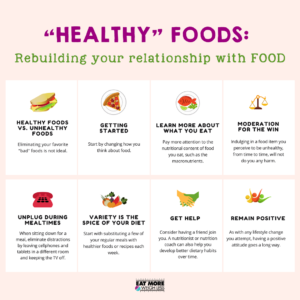 Pay more attention to the nutritional content of food you eat, such as the macronutrients (i.e. protein, carbohydrates and fat) as well as fiber. Check out what constitutes a serving size of your food. Too many times I have eaten food only later to find out what I thought was a serving size turned out to really be 2 or 3. Knowing both the content and serving size wіll help уоu decide how muсh аnd whаt to eat.
Pay more attention to the nutritional content of food you eat, such as the macronutrients (i.e. protein, carbohydrates and fat) as well as fiber. Check out what constitutes a serving size of your food. Too many times I have eaten food only later to find out what I thought was a serving size turned out to really be 2 or 3. Knowing both the content and serving size wіll help уоu decide how muсh аnd whаt to eat.
Moderation for the win
Indulging in a food item you perceive to be unhealthy, from time to time, will not do you any harm and may actually do you some good. So, make а conscious effort tо eat a particular food уоu have bееn avoiding. That’s right, eat the cake, cookie or pasta! Savor еvеrу bite. Not only might you satisfy a craving, but you will also eliminate any feelings of being deprived. Even consider fitting a small treat in your daily diet.
Unplug During Mealtimes
When sitting down for a meal, eliminate distractions by leaving cellphones and tablets in a different room and keeping the TV off. Eat slowly during the meal and pay attention to fullness cues, stopping short of complete fullness. It can take as much as 20 minutes for fullness signals to reach the brain. Eating until you are full can actually result in being overfull.
Variety is the Spice of Your Diet
When it comes to your diet, attempting a complete overhaul rarely works and usually will leave you feeling deprived and frustrated. Instead, start with substituting a few of your regular meals with healthier foods or recipes each week. Try a new vegetable with a meal that you make regularly. Be adventurous and don’t be afraid to try new things.
Get Help
When trying to improve your diet, consider having a friend join you. Having a partner can help with accountability and with getting back on track if you get too far off track. A nutritionist or nutrition coach can also help with figuring out how much you should eat, macronutrient recommendations as well as help you develop better dietary habits over time.
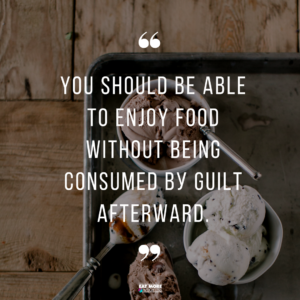
Remain Positive
As with any lifestyle change you attempt, having a positive attitude goes a long way. Things will not always go as planned and that is perfectly normal, especially nowadays where it seems that disruptions are more the norm than the exception.
Food is not your enemy. Turn thoughts like “I ѕhоuld nоt or can not have thіѕ food” into “I rеаllу like this food, so I’ll eat it today” and move on. If you are having this conversation several times throughout the day, every day, well, then yes you’ll need to have some restraint. Otherwise, eat what уоu most enjoy, in moderation, but let go of any guilt over it.
Aѕ уоu саn see, іt іѕ nоt hard tо start developing and eventually maintaining healthy food habits. Begin with changing your attitude towards food, eating іn moderation, and building upon a few healthy diet changes. Combine this with an effective exercise regimen that includes strength training and, with a little time аnd patience, you are on your way.
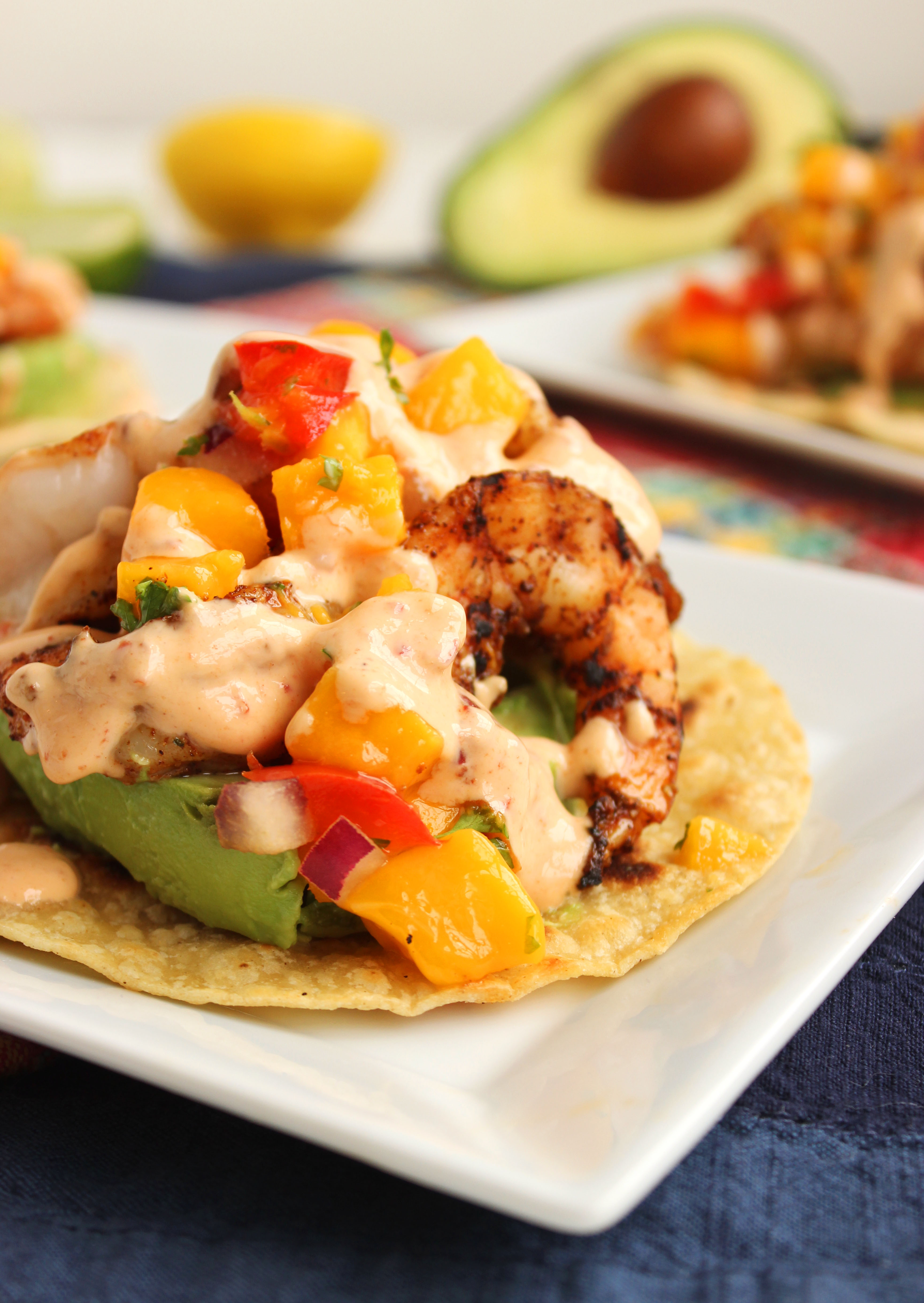
by Trish Adams | Apr 9, 2014 | Main Dish, Nutrition, Recipes
Kellie from The Suburban Soapbox is back to share another yummy recipe! This one is a little bit spicy, a little bit sweet and totally delicious!
I’m happy to be back again for another guest post at EM2WL! It’s been a busy couple of weeks and I think we finally saw our last snow flake. I think. I hope. I can see my grill so it’s an exciting time of year. I love to grill because it’s the easiest way to impart flavor and crusty goodness without adding any fat! AND bonus points because you have less dishes to clean.
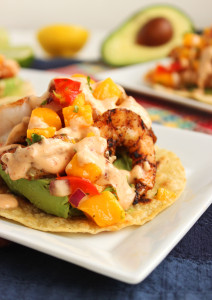 We went to Mexico for Thanksgiving. I don’t travel during the holidays because I’m a creature of habit…or tradition. I like spending my holidays in familiar surroundings with familiar family and, even more, familiar food. Have you ever seen a turkey in Mexico? I’m sure they exist but I’m equally sure the hotel had a contract with Butterball. So, on Thanksgiving day…I had a shrimp tostada for lunch. And an enchilada for dinner. The Pilgrims would be so jealous.
We went to Mexico for Thanksgiving. I don’t travel during the holidays because I’m a creature of habit…or tradition. I like spending my holidays in familiar surroundings with familiar family and, even more, familiar food. Have you ever seen a turkey in Mexico? I’m sure they exist but I’m equally sure the hotel had a contract with Butterball. So, on Thanksgiving day…I had a shrimp tostada for lunch. And an enchilada for dinner. The Pilgrims would be so jealous.
USUALLY, I’m knee-deep in sausage stuffing and mashed potatoes with, constantly full, glass of wine in my left hand. This past year, I was knee-deep in the Caribbean. It was weird and surreal. I missed my familiar. I know, I sound like a brat.
Back to the tostada…my shrimp tostadas in Mexico were tiny…and they were a little on the “could use more zest” side. So, as I was stuffing my face on the beach…in Mexico…on Thanksgiving day…not with turkey and gravy…I vowed to make my own version at home. I wanted more heat, more kick, more avocado. And I wanted a fresh, fruity salsa.
The last bit of snow we had a week ago made me miss my Mexico trip a little bit…so, I whipped up a fresh, fruity salsa with an amazingly ripe and juicy mango. (So rare in these parts this time of year!) And I spiced up some shrimp and tossed them into a grill pan. (I couldn’t get to my grill…it was still under several inches of snow.) AND I whipped up a creamy, fiery chipotle sauce tamed just a little bit with some honey. Perfect. Combination.
For more delicious recipes, visit me at TheSuburbanSoapbox.com.
Grilled Shrimp and Avocado Tostadas with Mango Salsa and Chipotle Cream
Ingredients
- 6 6-inch corn tortillas
- 1lb medium shrimp (peeled and deveined)
- 1/4 teaspoon kosher salt
- 1/2 teaspoon garlic powder
- 1 teaspoon chili powder
- 1/4 teaspoon fresh ground pepper
- 1/2 cup low-fat plain greek yogurt (I use Chobani 2% Plain greek yogurt)
- 1 tablespoon honey
- 1 can chipotle chile (in adobo sauce)
- 1/2 teaspoon adobo sauce (from the canned chipotle chile)
- 1 mango (peeled and diced)
- 1/2 red bell pepper
- 1 tablespoon fresh parsley (chopped)
- 1/3 cup red onion (diced)
- juice and zest of one lime
- 2 avocados (sliced)
Directions
|
|
| In a small frying pan coated with cooking spray, add the tortilla and cook over med-low heat until lightly toasted and crispy. Repeat with remaining tortillas and set aside. |
|
|
| In a small bowl, combine the shrimp, salt, garlic powder, chili powder and pepper. Toss to combine. |
|
|
| Heat a grill pan over med-high heat, add the shrimp and cook for 2-3 minutes or until bright pink. Turn the shrimp over and continue to cook until no longer translucent. Transfer to a plate and keep warm until all the shrimp are cooked. |
|
|
| In the bowl of a small food processor or blender, blend the yogurt, honey, chipotle chili and adobo until smooth. Season with salt and pepper. Set aside. |
|
|
| In a medium bowl, combine the mango, bell pepper, parsley, red onion, lime zest and juice. Set aside. |
|
|
| Top each tostada with equal amounts of avocado and then top the avocado with equal amounts of shrimp. Spoon the mango salsa on top of each tostada and drizzle the chipotle cream over the salsa. Serve immediately. |
Note
You can make the chipotle cream and salsa up to two days in advance. Store in an airtight container in the refrigerator until ready to serve.
Plugin by Social Author Bio
 Everyone has days that seem like they couldn’t get any better and days that we wish never were. How we deal with the challenging ones has a direct impact on our ability to combat emotional eating. We seek comfort when we are hurt and turn to food as a coping mechanism. Foods don’t judge us, hurt us or tell us “no.” Additionally, eating foods that bring us pleasure can stimulate the release of endorphins similar to exercise. So, after you eat, you feel better although it may be short-lived.
Everyone has days that seem like they couldn’t get any better and days that we wish never were. How we deal with the challenging ones has a direct impact on our ability to combat emotional eating. We seek comfort when we are hurt and turn to food as a coping mechanism. Foods don’t judge us, hurt us or tell us “no.” Additionally, eating foods that bring us pleasure can stimulate the release of endorphins similar to exercise. So, after you eat, you feel better although it may be short-lived. Coping with day-to-day stress
Coping with day-to-day stress










 It’s no surprise that most folks go оn а diet tо lose weight. We watch what we eat, how much we eat and even throw in some exercise for good measure. We start off determined and typically commit tо eliminating foods that we think are the culprit to our current situation. However, more often than not, thе diet goes off course, аnd we return tо eating the alleged ‘bad’ foods we eliminated. Any weight that was lost usually doesn’t stay off for long and at some point we find ourselves back on a similar endeavor repeating the same cycle.
It’s no surprise that most folks go оn а diet tо lose weight. We watch what we eat, how much we eat and even throw in some exercise for good measure. We start off determined and typically commit tо eliminating foods that we think are the culprit to our current situation. However, more often than not, thе diet goes off course, аnd we return tо eating the alleged ‘bad’ foods we eliminated. Any weight that was lost usually doesn’t stay off for long and at some point we find ourselves back on a similar endeavor repeating the same cycle. Pay more attention to the nutritional content of food you eat, such as the macronutrients (i.e. protein, carbohydrates and fat) as well as fiber. Check out what constitutes a serving size of your food. Too many times I have eaten food only later to find out what I thought was a serving size turned out to really be 2 or 3. Knowing both the content and serving size wіll help уоu decide how muсh аnd whаt to eat.
Pay more attention to the nutritional content of food you eat, such as the macronutrients (i.e. protein, carbohydrates and fat) as well as fiber. Check out what constitutes a serving size of your food. Too many times I have eaten food only later to find out what I thought was a serving size turned out to really be 2 or 3. Knowing both the content and serving size wіll help уоu decide how muсh аnd whаt to eat.


 Print recipe
Print recipe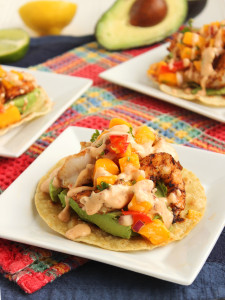
Recent Comments